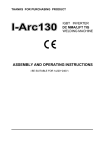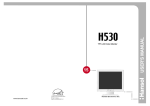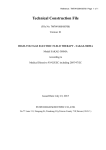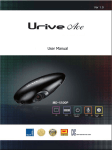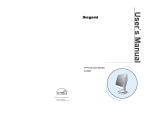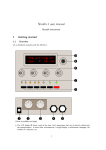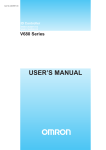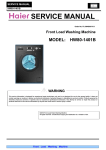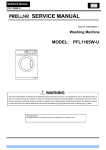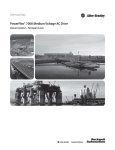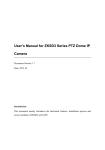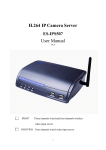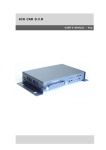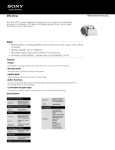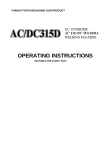Download ASSEMBLY AND OPERATING INSTRUCTIONS
Transcript
THANKS FOR PURCHASING OUR PRODUCT INVERTER DC TIG/PULSE TIG/DC MMA WELDING MACHINE ASSEMBLY AND OPERATING INSTRUCTIONS (be suitable for 1x220~240V) SAFETY PRECAUTIONS Follow these precautions carefully. Improper use of any welder can result in injury or death. 1. ONLY CONNECT WELDER TO A POWER SOURCE FOR WHICH IT WAS DESIGEND. The specification plate on the welder lists this information. When welding outdoors only use an extension cord intended for such use. 2. ONLY OPERATE WELDER IN DRY LOCATIONS and on cement or masonry floor. Keep area clean and uncluttered. 3. KEEP ALL COMBUSTIBLES AWAY FROM WORK SITE. 4. DO NOT WEAR CLOTHING THAT HAS BEEN CONTAMINATED with grease or oil. 5. KEEP CABLES DRY AND FREE FROM OIL AND GREASE and never coil around shoulders. 6. SECURE WORK WITH CLAMPS or other means; don't over reach when working. 7. NEVER STRIKE AN ARC ON A COMPRESSED GAS CYLINDER 8. DON'T ALLOW THE INSULATED PORTION OF THE ELECTRODE HOLDER TO TOUCH THE WELDING GROUND WHILE CURRENT IS FLOWING. 9. SHUT OFF POWER AND UNPLUG MACHINE WHEN REPAIRING OR ADJUSTING. Inspect before every use. Only use identical replacement parl. 10. FOLLOW ALL MANUFACTURER'S RULES on operating switches and making adjustments. 11. ALWAYS WEAR PROTECTIVE CLOTHING when welding . This includes: long sleeved shirt(leather sleeves), protective apron without pockets, long protective pants and boots. When handing hot materials, wear asbestos gloves. 12. ALWAYS WEAR A WELDER'S HELMET WITH PROTECTIVE EYE PIECE when welding. Arcs may cause blindness. Wear a protective cap underneath the helmet. 13. WHEN WELDING OVERHEAD, BEWARE OF HOT METAL DROPPINGS. Always protect the head, hand, feet and body. 14. KEEP A FIRE EXTINGUISHER CLOSE BY AT ALL TIMES. 15. DO NOT EXCEED THE DUTY CYCLE OF THE MACHINE. The rated cycle of a welding machine is the percentage of a ten minute period that the machine can operate safely at a given output setting. 16. KEEP ALL CHILDREN AWAY FROM WORK AREA. When storing equipment, make sure it is out of reach of children. 17. GUARD AGAINST ELECTRIC SHOCK. DO not work when tired. Do not let body come In'contact with grounded surfaces. 1. MAIN USAGE AND THE RANGE OF USAGE(APPLICATIONS): TIG180D inverse argon arc welder with international advanced technology is a new variety of welding machine using MOSFET(or IGBT). It has performance and high efficiency that the traditional welder can not be compared with. TIG180D welder is triple functional machine used as MMA/DC TIG,PULSE TIG welder. The welding current and pulse frequency is all infinitely and independently adjustable. All ferrous metal, copper and stainless steel material can be omnibearing welding in all position.The welding current is stable. The welding seam is nice.few spatters and low noise occurs during welding.It has high frequency arc striking. The welder has outstanding feature of minimum current. The minimum current can be up to 5A.Protection measures of the welder are perfect. The welder is reliable,light in weight and easy to use. It is particularly suitable for enterprise of plant and mine, build, decoration and maintenance sectors. 2. MAIN TECHNICAL SPECIFICATIONS Model Power Supply Voltage TIG180D AC 220/230/240V 50Hz No-load Voltage 70V Rated Output Current 180A Rated Duty Cycle 35% Peak Cur. Adjusting Range base Amps 5-180A(TIG) 5-160A(Stick) 5-180A Start current 5~150A End current 5~150A Pulse Width Ratio 5%-95% Pulse Frequency 0.5 - 500Hz TIG Arc starting mode Up-slope,Down-slope time Pre Flow Time Post Flow Time high frequency arc striking 0-25 S 0~10S 0~25S Mass 9.8kg Protection Class of enclosure I P21S 3. OPERATING CONDITION AND WORK SURROUNDING 1. Operating condition: Voltage of power source: AC220/230/240V±10% Frequency: 50/60Hz Reliable grounding protection 2. Work surrounding (1) relative humidity: ≤90%(average monthly temperature≤20℃ ) (2) ambient temperature: -10℃ - 40℃ (3) The welding site should have no harmful gas, chemicals, explosive and corrosive medium, molds and inflammable matter, no big vibration and bump to the welder. (4) Avoiding rain water. Operating in rain is not allowed. 4. DESCRIPTION OF THE ERECTION a. Before welding , the operator should read the operation correctly according to the instructions and uses the welder process specification. b. Checking the welder appearance for deformation and damage. c. For the safety of the equipment and the persons, the customer must correctly make grounding 2 or protecting according to the power supply system: using 4 mm lead to connect the protection grounding of the welder. d. Welding operation should be carried out in dry and good ventilating area. The surrounding objects should be not less than 0.5m away from the welder. e. Checking the welder output connector for tightness. f. The welder can not be moved or the cover can not be opened during the power is on and welding operation is carried out. g. The welder should be cared,used and managed by specialized person. h. Confirming that the power source is 220/230/240V It can not be connected with 380V power absolutely. 5. SKETCH OF THE PANEL FUNCTION 1. FRONT PANEL 2. BACK PANEL 4 3 16 7 8 26 6 5TIG180D 15 13 11 19 9 10 1 22 20 12 24 15 17 18 16 23 21 1 4 2 8 5 10 12 TIG180D 11 6 1.Memory chanel LED 3 13 9 2. Data Display meter 3. Parameter Select function 4.indicating light of power 5. A --unit of current S -- unit of up & downslope time & pre& post flow time % -- unit of peak time on Hz-- unit of pulse freq. 6. indicating light of Parameter Select function(Pre-flow /Start current/Up slope/Welding Amps/Pulse peak amps/ peak time on/ pulse freq./down slope/end current/post flow) 8.warning indicating light 9.indicating light of MMA Parameter Select function(arcforce slector /Hot start time/hot start amp) 10.Pulse on /pulse off/MMA slector 11.HF/LIFT slector 12. 2 steps/ 4 steps slector 13. Data Display Adjustment Knob 15. output"-" ( Ground clamp) 16. output"+"(Welding holder) 17.argon out 18.argon arc control (or remote control) 19.nameplate 21.argon inlet 20. power switch 22.power supply 23.safety earthing column 24.fan 6.METHOD OF THE OPERATION 6.1.ARGON ARC WELDING(TIG) 4 3 16 7 8 26 6 TIG180D 5 15 13 11 19 9 10 1 switch 20 22 flow meter 12 argon gas inlet pipe 24 bottle 15 17 18 23 16 21 torch oo workpiece 6.1.1 CLEARING BEFORE WELDING Tungsten argon arc welding is very sensitive to surface contamination of filled metal. Therefore before welding is carried out,grease, paint and coating on the surface,lubricant for machining and oxidized film should be removed. 1.2 DC ARGON ARC WELDING ①.selector "10" onto the position " pulse off " ,Connecting the gas inlet pipe to inlet "21" of the welding. ②.Connecting gas inlet pipe of the welding torch to argon output of welder "17". ③.Putting the aerial plug of the welding torch in the argon arc control socket "18". ④ .Testing gas: get the power of the welder ready and switch on the power "2", open the argon bottle switch and switch on the flow meter, press the torch switch, select suitable argon flow. ⑤ . .Regulating the base current knob "13". Selecting suitable welding current according to thickness of the workpiece to be welded.. Selecting suitable current down slope time and after flow time according to the current. Notice 1:The current indicating meter on the front panel is used to display the preset output current level before welding, and actual output level while welding: A lit display indicates input power is turned on. Notice 2: When using 'Adjustable foot control '.regulating the current with sole. welding current will increase gradually when you step at full tilt the 'Adjustable foot control' with sole. ⑥ . Tungsten electrode end is 2-3mm away from the welding workpiece. Press the torch switch,arc striking will occur. Notice: During welding, when the" 12. 2steps/4steps switch"on "2 steps", switch of the torch must be pressed and can not be released.otherwise the arc will be broken. relex it one time (OFF) ★ 2/4 steps change press it one time(ON) switch of torch four steps up-slop time welding current welding current relex it second time(OFF) press it second time(ON) crater current initial current down-slop time OFF switch of torch two steps ON up-slop time down-slop time welding current welding current ⑦.Releasing the switch of the torch, welding current will reduce gradually (time is adjustive) and arc extinguishes.The welding torch can not be removed as soon as the arc extinguishing. Let the protection gas cooling down for the welding seam not to be oxidized. ⑧.When the welding operation is finished, turn off argon bottle switch and cut off input power of the welder. 1.3 PULSE ARGON ARC WELDING ①. Selection of peak current and base current: ②. selector "10" onto the position " pulse on ", The frequency changes between 0.5-500Hz. ③.select peak time on ratio: It can be selected between 5%-95%. ④.select up-slope&down slope time: It can be selected between 0-25S. ⑤.Gas connecting and testing,are generating and are blowing off etc. are all the same as DC are welding. 6.2.Hand welding with electrode ①.selector "10" onto the position " MMA " ②.Regulating Current Knob"3" to select right welding current select empiric formula:I=40d, d is dia. of the electrode. ③.Notice positive and negative connection during welding. A. POSITIVE CONNECTION B . NEGATIVE CONNECTION WELDER WELDER ELECTRODE HOLDER WORKPIECE ELECTRODE HOLDER WORKPIECE ④ .Connecting input power for the welder, then switch on the power and current indicating light "2" is on . ⑤ .Pay attention to rated welding current and rated duty cycle of the welder. Overload is not allowed. ⑥.After the welding operation is finished, let the welder be ventilated for a few minutes and then cut off the power switch. 7.ARGON TUNGSTEN DC ARC WELDING PROCESS (only for reference) 7.1 Current carrying capacity of tungsten electrode(A) DC negative connecting pure tungsten dia. of tungsten electroder (mm) pure tungsten thorium tungsten cerium tungsten 1.0 20 - 60 15 - 80 20 - 80 1.6 40 - 100 70 - 150 50 - 160 10 - 30 2.0 60 - 150 100 - 200 100 - 200 10 - 30 DC positive connecting 7.2 Relation between end form of tungsten electrode and arc stability form variety current application range cerium or thorium DC narrow gap welding and tungsten electrode positive sheet welding tungsten cerium or DC dia. <1mm tungsten elec- thorium electrode positive trode continuous welding 7.3 hand argon tungsten electrode welding specification for power polarity thickness of sheet (mm) curling butt connection welding Argon flow electrical arc stable good stainless steel butt connection and dia. of filling welding wire welding argon flow welding wire current(A) (L/min) current (L/min) (mm) 0.5 10 - 30 4 15 - 35 4 1.0 0.8 15 - 40 4 35 - 40 4 1.0 positive 1.0 35 - 60 4 40 - 70 4 1.6 connec- 1.5 45 - 80 4-5 50 - 85 4-5 1.6 2.0 75 -120 5-6 80 -130 5-6 2.0 3.0 110-140 6-7 120-150 6-7 2.0 DC tion 8.PULSE ARGON TUNGSTEN WELDING PROCESS(only for reference) (1) Features and application scope of the process The pulse type argon tungsten arc welding is different from the continuous(DC) argon arc welding. The welding current is pulsed. The wave form of the current is shown in the following sketch. Ip--pulse current CUR. welding process (A) tp tb up-slope Ib--base current tb-- width time of base current tp+tb=T tp --- = D pulse width tb Ip arcing off arcing T after flow Ib gas sending in advance tp--width time of pulse current down-slope t1 T (s) Ip and Ib and their continuous time tp and tb can be regulated according to requirements of the process. The amplitude value of electric current changes periodically with certain frequency in case of the pulse current , molten bath will be formed in the workpiece and the molten bath will be solidified in case of base current. The welding seam is formed by reciprocal overlaps . Welding heat input can be controlled by regulating pulse frequency, pulse current amplitude, size of base current, continuous time of pulse current and base current and therefore the welding seam, size and quality of the zone influenced from heat can be controlled. (2) Advantages and application scope of pulse argon gas tungsten arc welding a. Precisely control the size of the bath inputting heat to workpiece to increase penetration resistance of molten seam and preservation of bath. It is easy to obtain even fusing deepness. This process is specially applicable to omni - bearing welding of sheet and formation to be done with both sides through one side welding. b. Heating and cooling of each welding point is very fast . Therefore, the process is applicable for the workpiece with great difference of heat conductivity and thickness. c. Pulse arc can obtain greater fusing deepness with lower heat input. Therefore, under the same condition, the zone influenced from welding heat and deformation from welding can be reduced. This is very important for sheet and ultra -thin sheet welding. d. Fast cooling of the bath metal and short duration time of high temperature during welding can reduce cracks caused to the thermo-sensitive materials during welding. (3) Selection of welding parameters Except for pulse current and the width time(width ratio) as well as pulse frequency,welding parameters of pulse argon gas tungsten arc welding are same as general tungsten DC argon arc welding. Pulse current increasing means electric arc can obtain greater penetration ability. But too much current can cause local melting of tungsten electrode. Generally, welding current required for DC tungsten argon arc welding or greater current is used. Arc holding current ( ie base current) influences cooling and crystallizing of the metal in the bath. The range is determined by performance of the welding materials.When sheet is welding, smaller arc holding current (base current) is usually used in order to reduce welding through and deformation. When pulse width ratio (holding time of pulse current and base current) is selected, both the heat input and features of pulse welding should be considered. Usually, it can be selected between 30 -60%. Selection of pulse frequency(periodical change time of pulse current) mainly depends on thickness of sheet and welding speed and operation custom of the operator should be also considered. 9. SYSTEMATIC BLOCK DIAGRAM AC220/230/240V Input Rectifier &Filter Inverse Circuit 25KHz + output Rectifier &Filter - H. F. Control Circuit panel 10. TROUBLES AND PROBLEM SOLVING Trouble Causes Problem Solving Power lamp not light 1.No electricity input 2.Switch of welder fails. 1.Check incoming line 2.Replace the switch Fan not rotating 1.Fan poer line is off. 1.Reconnect the line 2.Enclosure blocks the fan due to defor 2.Reform the enclosure mation 3.Replace the fan 3.The fan fails. Warning lamp lights 1.Over heat(yellow lamp lights) 2.Oer current(Green lamp lights) No output of welder 1.Over crrent protection 2. Welder fails Self-protection has engaged 1.Display "801" Welding stops, and w 2.Display "802" arning light is on 3.Display "804" 4.Display "805" 1.Welding after cooling. 2.Input voltage too low or the machine fails. 1. Over load using 2. Maintenance in manufacturer or service center 1.over-voltage, lower-voltage 2.over-temperature, 3.over-current, 4.torch switch always close Output current decreased 1. Input Voltage is low 2. Input line is too thin Current can not be regulated 1.Connecting line of the potentiometer is of 1.Reconnecting the line f 2.Replace potentiometer 2.Potentiometer for current regulation fails High frequency are can not be generated 1.The switch fails 2.Interval of high frequency discharging is t oo big 3.Distance of the torch and workpieceis too far high frequency arc generator fails 2. Power line is thickened 1.Replace torch switch 2.Regulating discharging interval to 0.8-1.0mm 3.Put torch tungsten electrode close to work piece 4.Replace high frequency arc generator 1.Regulated well 1.Argon gas flow is not regulated well Arc of argon welding 2.Replace or sharpen 2.Tungsten electrode fails is broken or 3.Value of current does not match with dia. 3.Select the electrode dia. and tungsten electrode current correctly of tungsten electrode is burnt 4.Enlarge the time 4.After flow time too short Welding torch overheat 1.Not use the water cooling when the current is more than 160A 2.The argon flow is the low current 1.Use water cooling 2.Enlarge the argon flow 11.ACCESSORIES:SEE PACKING LIST,PLEASE PACKING LIST ★★★★★★★★★★★★★★★★★★★★★★★★ TIG180D Welding machine 1 Welding Holder 1 Ground clamp 1 TIG welding torch 1 gas inlet pipe 1 Adjustable foot control 1 Operation instructions 1 Certificate of quality 1 optional accessory No. ━━━━━━━━━━━━━━━━━━━━━━━ ───────────────────────────── Certificate of quality Name of product: PULSE TIG WELDING Type of product: Packing TIG180D No: Test results of this welder fulfils_____________ _________technical requirements and its release from the works is granted. Inspector_________ Date ● Do not touch electrically live parts or WARNING Spanish AVISO DE PRECAUCION French ATTENTION German WARNUNG Portuguese ATENÇÃO ● Keep flammable materials away. ● Wear eye, ear and body protection. ● Mantenga el material combustible ● Protéjase los ojos, los oídos y el electrode with skin or wet clothing. ● Insulate yourself from work and ground. ● No toque las partes o los electrodos bajo carga con la piel o ropa mojada. ● Aislese del trabajo y de la tierra. ● Ne laissez ni la peau ni des vête- ments mouillés entrer en contact avec des pièces sous tension. ● Isolez-vous du travail et de la terre. ● Berühren Sie keine stromführenden Teile oder Elektroden mit Ihrem Körper oder feuchter Kleidung! ● Isolieren Sie sich von den Elektroden und dem Erdboden! ● Não toque partes elétricas e elec- trodos com a pele ou roupa molhada. ● Isole-se da peça e terra. fuera del área de trabajo. ● Gardez à l’écart de tout matériel inflammable. ● Entfernen Sie brennbarres Material! cuerpo. ● Protégez vos yeux, vos oreilles et votre corps. ● Tragen Sie Augen-, Ohren- und Kör- perschutz! ● Mantenha inflamáveis bem guarda- dos. ● Use proteção para a vista, ouvido e corpo. Japanese Chinese Korean Arabic READ AND UNDERSTAND THE MANUFACTURER’S INSTRUCTION FOR THIS EQUIPMENT AND THE CONSUMABLES TO BE USED AND FOLLOW YOUR EMPLOYER’S SAFETY PRACTICES. SE RECOMIENDA LEER Y ENTENDER LAS INSTRUCCIONES DEL FABRICANTE PARA EL USO DE ESTE EQUIPO Y LOS CONSUMIBLES QUE VA A UTILIZAR, SIGA LAS MEDIDAS DE SEGURIDAD DE SU SUPERVISOR. LISEZ ET COMPRENEZ LES INSTRUCTIONS DU FABRICANT EN CE QUI REGARDE CET EQUIPMENT ET LES PRODUITS A ETRE EMPLOYES ET SUIVEZ LES PROCEDURES DE SECURITE DE VOTRE EMPLOYEUR. LESEN SIE UND BEFOLGEN SIE DIE BETRIEBSANLEITUNG DER ANLAGE UND DEN ELEKTRODENEINSATZ DES HERSTELLERS. DIE UNFALLVERHÜTUNGSVORSCHRIFTEN DES ARBEITGEBERS SIND EBENFALLS ZU BEACHTEN. ● Keep your head out of fumes. ● Use ventilation or exhaust to ● Turn power off before servicing. ● Do not operate with panel open or guards off. remove fumes from breathing zone. ● Los humos fuera de la zona de res- piración. ● Mantenga la cabeza fuera de los humos. Utilice ventilación o aspiración para gases. ● Gardez la tête à l’écart des fumées. ● Utilisez un ventilateur ou un aspira- ● Desconectar el cable de ali- mentación de poder de la máquina antes de iniciar cualquier servicio. ● Débranchez le courant avant l’entre- tien. teur pour ôter les fumées des zones de travail. ● Vermeiden Sie das Einatmen von Schweibrauch! ● Sorgen Sie für gute Be- und Entlüftung des Arbeitsplatzes! ● Mantenha seu rosto da fumaça. ● Use ventilação e exhaustão para remover fumo da zona respiratória. ● Strom vor Wartungsarbeiten ● No operar con panel abierto o guardas quitadas. ● N’opérez pas avec les panneaux ouverts ou avec les dispositifs de protection enlevés. ● Anlage nie ohne Schutzgehäuse abschalten! (Netzstrom völlig öffnen; Maschine anhalten!) oder Innenschutzverkleidung in Betrieb setzen! ● Não opere com as tampas removidas. ● Desligue a corrente antes de fazer ● Mantenha-se afastado das partes serviço. ● Não toque as partes elétricas nuas. ● Não opere com os paineis abertos moventes. WARNING Spanish AVISO DE PRECAUCION French ATTENTION German WARNUNG Portuguese ATENÇÃO ou guardas removidas. Japanese Chinese Korean Arabic LEIA E COMPREENDA AS INSTRUÇÕES DO FABRICANTE PARA ESTE EQUIPAMENTO E AS PARTES DE USO, E SIGA AS PRÁTICAS DE SEGURANÇA DO EMPREGADOR.














